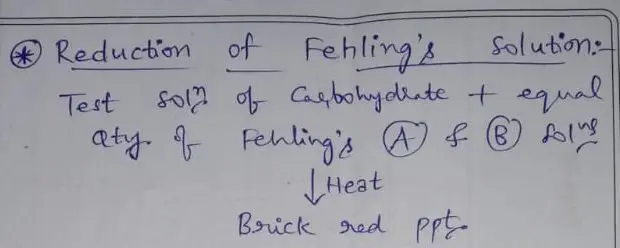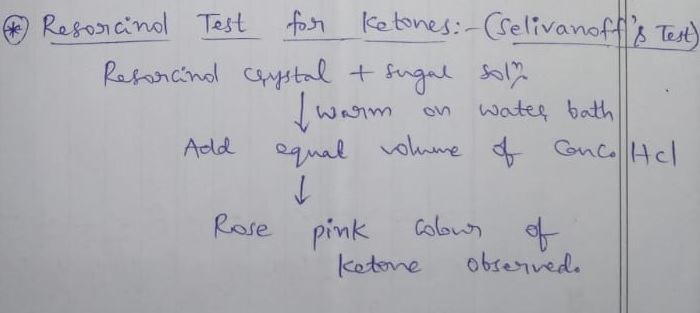Carbohydrates are quite common in many samples, including our food.
The tests for carbohydrates are many and vary depending on the type of carbohydrate under analysis.
However, we can list them in 8 tests below
Test for carbohydrates:
- Fehlings test
- Molisch’s test
- Osazone formation test
- Selivanoff’s test
- Test for pentoses
- Keller Kiliani test
- Enzyme reactions
- Chromatography.
Fehling’s test
This test relies on the reduction of Fehling’s solution. Reducing sugars like all the monosaccharides and disaccharides like lactose maltose can be tested.
Besides, non-reducing sugars like sucrose and polysaccharides can also be tested.
However, non-reducing sugars need to be boiled with acids to convert into reducing sugars. This fehling’s test for carbohydrates is the most commonly used method to identify carbohydrates.

Method: To a boiling solution of the sample substance, add equal volumes of Fehling’s A and B solutions. A red-colored precipitate of cuprous oxide develops, which indicates the presence of carbohydrates.
Molisch’s test for carbohydrates
This test also applies to the detection of all carbohydrates. Here, to a solution of carbohydrates, α-naphthol is added, and then concentrated sulphuric acid is added from the top.
The presence of carbohydrates gives a purple-colored ring at the top of the solution in a test tube.

The importance of the Molisch test lies in that it can be used to identify even insoluble carbohydrates like cotton wool.
Osazone formation Test:

When sugar solutions are heated with phenylhydrazine hydrochloride, sodium acetate, and acetic, osazone is formed.
When observed under a microscope, yellow-colored crystals can be seen, which are characteristic of certain sugars.
Selivanoff’s test:
This is a resorcinol test for ketone sugars.

Here, a crystal of resorcinol is added to the sample solution and warmed with an equal volume of hydrochloric acid.
Rose color is produced if ketones like fructose hydrolyzed inulin are present.
Pentoses test

To a sample solution in a test tube, little phloroglucinol is added.
Further, equal volumes of hydrochloric acid are added and heated. The formation of red color indicates the presence of pentose sugars.
Keller-kiliani test
This reaction is explicitly meant to determine the deoxysugars. These sugars are part of cardiac glycosides like the digitalis and strophanthus.

To the sample, add sufficient acetic acid and a little ferric chloride.
Put this solution on the surface of concentrated sulfuric acid. At the junction of liquids, a reddish brown color is produced, which turns to blue.
Enzyme reactions: Here, enzymes are used to identify specific carbohydrates.
Chromatography: Thin-layer chromatography can easily identify samples from plant extracts containing carbohydrates, gums, and mucilage.
this is very very helpful for my experiment